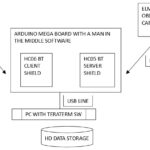Experiencing a change in your vehicle’s handling after wheel bearing replacement can be unsettling. One common concern voiced in automotive forums highlights a “floaty” steering feel, particularly in the front end, subsequent to this repair. Coupled with intermittent ABS and Traction Control lights illuminating and then mysteriously disappearing, drivers are left scratching their heads, wondering if the issues are related to the recent work or if something more sinister is at play. Let’s delve into these symptoms, focusing on how your OBDII system can be a valuable tool in diagnosing potential problems.
The initial concern of “floaty” steering after wheel bearing work could stem from a few possibilities. While seemingly unrelated, the process of replacing wheel bearings does involve disconnecting and reconnecting various suspension and steering components. It’s crucial to ensure all these components, such as tie rods and ball joints, are properly tightened and aligned after the bearing replacement. A loose steering rack could also contribute to a vague or “floaty” feeling, and while less directly related to wheel bearing replacement, it’s worth checking as a potential culprit. Improper installation of the wheel bearing itself, though less common with professional mechanics, could theoretically also impact handling.
The intermittent illumination of the ABS and Traction Control lights, especially in conjunction with recent wheel bearing work, strongly suggests a potential link to the wheel speed sensors. These sensors are integral to both the ABS and Traction Control systems, and they are often located within or very near the wheel bearing assembly. During a wheel bearing replacement, these sensors can be disturbed, damaged, or their connections loosened.
The fact that an initial OBDII scan didn’t reveal any error codes related to the ABS system doesn’t immediately rule out a sensor issue. Some generic OBDII readers have limited capabilities in reading ABS-specific codes. A more advanced scan tool, like those offered by Autel, with enhanced diagnostic functions, might be necessary to properly interrogate the ABS module and retrieve any stored or pending codes.
Here’s where your OBDII tool becomes invaluable. A comprehensive scan tool can:
- Read ABS and Traction Control fault codes: Even if the lights are intermittent, the system may have stored codes that can pinpoint the problematic wheel speed sensor or circuit.
- Monitor live sensor data: By observing the real-time readings from each wheel speed sensor while driving or rotating the wheels, you can identify if a sensor is providing erratic or no signal. This is crucial for diagnosing intermittent faults.
- Check for communication errors: As mentioned in the original forum post, some vehicles can exhibit communication issues with certain OBDII devices. Using a reputable and compatible scan tool is essential to ensure reliable data retrieval.
Beyond sensor issues directly related to the wheel bearing replacement, other factors could trigger ABS/Traction Control lights. Low brake fluid, issues with the brake light switch, or even general electrical glitches can sometimes cause these systems to flag errors. However, given the recent wheel bearing service, focusing on the wheel speed sensors and their connections is a logical first step.
In conclusion, if you’re experiencing “floaty” steering and intermittent ABS/Traction Control lights after wheel bearing replacement, don’t panic. Systematically investigate the potential causes. Start by visually inspecting the suspension and steering components for looseness. Then, utilize a professional-grade OBDII scan tool to delve deeper into the ABS system. Reading fault codes and monitoring live sensor data are key steps in isolating whether a wheel speed sensor, its wiring, or another related component is the source of your vehicle’s post-repair symptoms. Remember, accurate diagnosis is the first step towards an effective and lasting repair.

